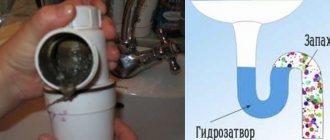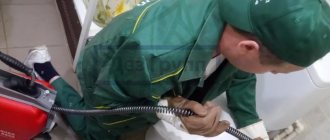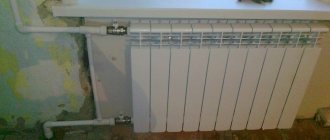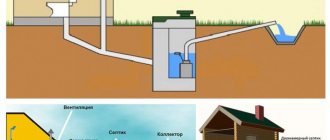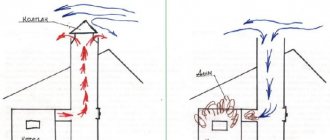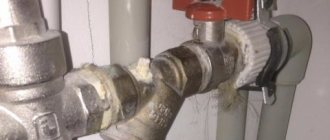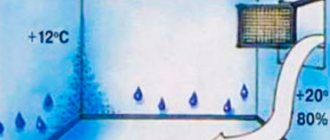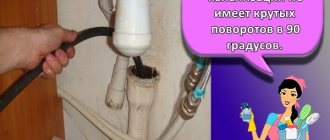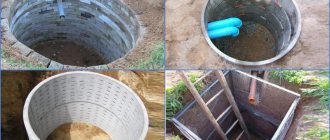We have an air lock in the sewer, how can we eliminate it and prevent it from appearing again? Similar questions often appear on thematic forums or other public pages dedicated to the operation of drainage systems.
The problem is quite rare, but this only makes it more complicated - few people understand the reasons for its occurrence. Eliminating such a malfunction is not easy - you must first find the place where it appeared, find out the cause, and only then correct the configuration of the drainage line. The problem will not disappear on its own; it must be solved immediately. Let's figure out together how air pockets appear and what to do about them.
Types of sewer clogs
If the sewer system in a house is operated in violation of all the rules for its use, then over time, blockages and plugs inevitably appear in the collector, which impede or completely stop the flow of wastewater. As a result, either someone from an apartment building or the owners of a private building will suffer from at least an unpleasant odor in the living space. The maximum possible flooding of the kitchen or bathroom with fecal water. This is not very pleasant, so to avoid such situations you need to use the collector correctly, namely:
- It is strictly forbidden to flush used personal hygiene items, such as pads, diapers, tampons, etc., down the toilet. Only flushing toilet paper is allowed.
- It is prohibited to flush bulk construction mixtures such as cement, sand, chalk, clay, etc. down the drain.
- Accidental flushing of rags and other similar items down the drain should be avoided.
- It is advisable to install grease traps in the kitchen, which will prevent the deposition of heavy greasy deposits on the walls of the collector. This, in turn, can create fecal growths-stalactites in the system and impede the flow of gray water.
It is always worth remembering that a traffic jam can form either in a specific place in the sewer system in an apartment or in a private house, or at any point in the central riser. If the last option is checked, then the drains will have nowhere to go but to return back from the blockage under the influence of hydraulic force. As a result, fecal or gray water will try to escape through the unoccupied openings of the bathtub, sink, and other plumbing fixtures.
Hydrodynamics for sewer cleaning
If the above cleaning methods do not help and the water also slowly flows into the collector, creating unpleasant odors in the system, you can invite specialists to flush the collector using a hydrodynamic method. In this case, special equipment is used that supplies water to the system under high pressure. Thanks to the high power of the supplied jet, the collector is cleared of all plugs and blockages. It is fashionable to clean pipes with a diameter of 5 to 100 mm in this way.
The official application from the bookmaker 1xBet is absolutely free and you can click on the link and place bets on sports.
Important: you can also use a similar technology for cleaning the system in an apartment. But it is necessary to invite specialists who have the appropriate equipment.
What kind of blockages can there be and how to determine their cause
All sewer blockages are divided into several types:
- adhesion of fat to the internal surfaces of the pipe and adhesion of other waste. Such a blockage is usually called operational;
- the mechanical appearance differs from the previous one in that the cause of clogging is the entry of a foreign object into the system;
- as a result of the appearance of a fatty layer, a siphon blockage may occur;
- There is also a man-made problem, the cause of which is an error during installation of the system.
If the main access riser on the lower floor becomes clogged, then all the contents in the pipe rise up and come out in someone’s toilet, bathroom or kitchen. In such situations, you need to urgently call a specialist, since it is unlikely that you will be able to fix the problem yourself.
Finding an air lock in a sewer pipe
Ways to solve the problem
You can use regular soda to clean drains. To dilute the correct solution, you need to prepare several liters of boiling water in which a pack of soda will dissolve. The prepared liquid should be poured into the drain hole, and it is recommended to gradually add vinegar. In this way, a reaction can be achieved that will promote the rapid decomposition of fat
Most often, this method is used if there are no special means at hand, which include Mole, Tiret, etc. You can use chemicals yourself, but it is important to follow basic safety rules. Immediately before cleaning the sink, toilet or bathtub, you need to familiarize yourself with the operating instructions for a particular product.
It is better to use this cleaning method when the pipe is not yet completely clogged, this way you can achieve greater efficiency. When the drain is completely clogged, it is dangerous to use chemicals because they can back up into the bathtub or sink. A proven and reliable method of cleaning is to use a simple plunger. When actions using soda or chemicals do not bring much effect, then this method can be used. In such cases, it is important that the bowl of the plunger completely covers the drain hole.
How to fix the problem using a plunger?
Actions are performed in a certain sequence:
- a sample filter is removed from the hole;
- the top hole of the bathroom must be tightly closed to achieve greater efficiency during the work process;
- The plunger must be installed so that no air lock appears, while the handle is placed vertically;
- without lifting the device from the bottom of the bathtub, you need to move the device up and down;
- on the last movement, the plunger rises from the water to check the effectiveness of its drainage. If necessary, the procedure is repeated several more times.
Another proven device is a metal cable, which is often used by plumbers. At one end of such an object there are fluffy wires, on the other side of the cable there is a handle for convenient use. The first end is inserted into the pipe, and rotational movements must be made using the handle. Depending on the degree of pipe clogging and the location of the problem, cleaning can take a relatively long time. If the problem is solved quickly, then the length of the cable is sufficient to effectively penetrate the sewer.
Mechanical blockage
What is this?
Has the water in the sink or bath started to drain poorly, or even worse, has an unpleasant smell appeared? These signs indicate a mechanical blockage. This is a fairly common occurrence, since with the constant use of plumbing fixtures, food debris, hair or pet fur, small debris, etc. accumulate in the pipes.
TOOLS FOR HOME AND GARDEN, HANDCRAFTS, ETC. PRICES VERY LOW
How to fix it?
Most often, mechanical blockages are shallow and can be easily removed with an ordinary plunger. To clear a clog in your sink or bathtub, follow these steps:
1) close the overflow hole (plug with a rag or seal with tape);
2) press the plunger to the drain hole;
3) pump the air up and down with a plunger until the water goes away, repeat these operations if necessary.
To remove blockages in the toilet, use a special plunger with a narrow ring at the end. Ideally, the diameter of this ring should match the diameter of the drain hole. The plunger must be pressed against the drain hole and rocked back and forth several times. If the water drains freely, everything is done correctly and the blockage is removed!
Prevention
To prevent this type of clog, install a dirt, hair and waste trap (also called a “trap”, or less commonly a “filter”) in the drain hole of the sink or bathtub. It is a plastic, silicone or metal strainer that catches the smallest particles of debris.
Danger of air bubbles in the pipeline
Bubbles, especially large ones, can destroy even strong elements of the highway. The main troubles they cause to owners of private houses:
- They accumulate in the same areas, leading to breakdowns of pipe sections and adapters. They also pose a risk for turning and twisting pipe sections where air is trapped.
- They break the water flow, which is inconvenient for the user. The taps “spit out” water all the time and vibrate.
- Causes water hammer.
Water hammer leads to the formation of longitudinal cracks, which causes the pipes to gradually collapse. As time passes, the pipe breaks at the point of cracking and the system stops functioning.
Therefore, it is important to equip additional elements that allow you to quickly get rid of dangerous bubbles
How does education happen?
The correct start of the heating system is one in which it is filled through the return line using a make-up pump. When filling the system through the return line, the filling process is performed from the bottom up, the coolant gradually begins to fill all pipelines and heating devices, and excess air rises. As a result, it is very easy to drain it from the system using air collectors located at the highest points.
However, the process, sequence and incorrect start-up are not the only reasons why an air lock forms in the heating system. During operation of the heating system, air is sucked in through flange and threaded connections, as well as other existing leaks, which leads to the formation of a plug.
Mayevsky crane
Design of the Mayevsky crane
It is designed to eliminate air lock in the heating battery. Despite its small size, the Mayevsky faucet helps to effectively remove accumulated steam not only in radiators, but also in pipes.
Structurally, it is a needle valve enclosed in a metal housing. How to remove an air lock from a heating system using it? First you need to decide on the device model.
Manual taps
After installation in the upper radiator pipe, air is released after turning the union nut on the tap. Removing an air lock from the heating system using a Mayevsky manual tap is carried out according to the following scheme:
- Filling the system with coolant. The taps on the radiators are closed;
- When the maximum level is reached, the water supply stops;
- Having set the required gap of the needle limiter in the devices, the taps are opened;
- At the same time, the coolant supply is restored.
Water is added to the system until liquid begins to flow from all Mayevsky taps. Be sure to check that there is no air flow. This method is effective for removing air locks in heating radiators when starting the system for the first time, before the season, or when airiness appears during operation.
Manual models will effectively eliminate air lock in the radiator for both autonomous and central heating. The main thing is to choose the right mounting thread. In most cases it is 1/2", but there are models with a non-standard size of 3/4".
Automatic taps
Mayevsky automatic crane
Unlike the model described above, in their design, a seat with a certain surface area is installed on the end of the needle valve. In combination with a return spring, the degree of pressure of which determines the critical pressure value at which the valve opens. A detailed device is designed to automatically break through a heating plug when a critical temperature value and, as a result, pressure is exceeded.
However, before installation you should familiarize yourself with the specifics of this model:
- To prevent water from getting onto the floor, the structure must have a pipe to drain excess water into the sewer;
- If it sits for a long time, the valve seat may become covered with limescale, which will make it difficult to open. Therefore, it is recommended to open the tap manually once every 2-3 months. The steps of the procedure must be done before starting the heating for the first time;
- The set maximum opening pressure should not exceed the critical pressure of the entire system. In order to remove an air lock from the heating in automatic mode, the pressure value on the tap should be 5-10% less than the maximum.
What is better to install: an automatic or manual Mayevsky crane? If the operation of the system does not involve sudden pressure surges, manual models can be installed on the radiators. For autonomous heating, preference is given to automatic ones.
It is best to choose models made of brass. During the expulsion of an air lock from the heating, they can withstand not only a critical pressure value, but also a temperature. The steel body is subject to destruction and rusting.
Installation rules
If it is impossible to fix the breakdown and the siphon needs to be changed, experts recommend knowing and using the rules for installing and dismantling the device.
Stages of dismantling:
- disassembling a deformed device;
- disconnecting the siphon and adjacent pipes from the sewer;
- removal of dirt and residues of rubber parts.
Before installing a new device, be sure to check that all components are included in the purchased kit.
The set contains:
- outlet pipe;
- plastic nuts;
- gaskets for inlet and drain;
- stainless steel clamping screw;
- conical rubber cuff;
- drain cover;
- curved pipe or special flask;
- rubber plug.
Only if all the above parts are available can you begin to install the product.
Installation steps:
- preliminary assembly of the structure;
- connection of the overflow to the bathtub;
- tight fixation of all elements and simultaneous use of sealing parts;
- installation of the main drain and pipe;
- siphon installation.
Fixing the problem
You can solve the air lock problem yourself. The main thing is to identify the reason for its formation.
- First, it is worth inspecting the pipeline along its entire length for cracks or depressurization (provided that the sewerage system has a water seal). If any are found, it is worth replacing the collector section with a whole one. In this case, the air will freely flow into the drain pipe during a volley discharge of water into the system. That is, the water seal cover will close when the pressure in the pipeline increases and thereby prevent stagnation of water.
- If an air lock is observed in the area of a specific plumbing fixture, then perhaps the slope of the pipes towards the riser was not observed during installation. To do this, you need to reposition the pipeline section to create the required slope or, if possible, raise the plumbing fixture to create the optimal level of slope for the drains.
- If the sewerage system basically does not have a drain pipe, then it will have to be installed with the installation of water seals near each plumbing fixture.
And always remember that if you are not confident in your abilities and think that you are prone to make mistakes when installing sewerage in your home, it is better to use the services of professionals. The craftsmen will create a reliable drainage system with a properly functioning drain pipe,
Most often, clogged sewer systems occur in old houses, and the reasons for this phenomenon can be completely different.
For example, due to the owner’s negligence, a rag or some hard object may get stuck in the system. Over time, the diameter of the pipe narrows as fat deposits form on its walls.
Therefore, a minor blockage can cause a big problem. Depending on the nature of the problem, there are several solutions that can be used to effectively clean the sewer with your own hands without calling a professional.
Hydrodynamic pipe cleaning
If all known means are ineffective, it is recommended to use a special technical device with which hydrodynamic cleaning is carried out. This method is considered very effective.
Such machines differ in power and overall dimensions. It is allowed to clean pipes whose diameter can be 5-100 cm.
checking sewer pipe connections for leaks after removing the airlock mechanically
Air lock problem
Nowadays, plastic pipes are very popular, which are distinguished not only by good performance characteristics, but also by easy installation. Not everyone who installs plastic pipes is a specialist, so when choosing consumables for installing a sewer system, various types of mistakes can be made. Common mistakes when choosing and installing a system include:
- incorrect determination of pipe diameter;
- unnecessary turns during the installation process;
- laying sewer pipes at the freezing level of the ground;
- lack of means in large areas to control the operation of the system.
The last point is often the cause of blockages. Also, sewerage can freeze in the winter. The appearance of both fat and air plugs is often observed.
The most difficult issue to resolve is that of an air lock in the sewer; not everyone knows how to fix this problem. If it is serious enough, then there may be a need to rebuild the entire sewer system. Before making such drastic decisions, you need to try to eliminate the problem yourself, using some simple methods.
removing an air lock from a sink drain pipe
How to get rid of an air lock?
If an air lock appears in a specific section of the pipe, for example, in the sink drain in the kitchen, bathroom or toilet, the essence of the problem may be:
- in the farthest location of the plumbing fixture from the riser;
- due to an installation error when pipes were installed with the wrong slope.
To solve such problems, you can simply re-lay the sewer sample to the riser, taking into account the correct level of inclination. In some situations, it is enough to simply raise the plumbing fixture to the required level. Thus, due to the level difference, you can get rid of problems with an air lock.
If there is an air lock in every plumbing fixture, then most likely the design of the air duct was not thought through during the installation of the system. In such a situation, it is recommended to make an open sewer riser on the roof, through which air is released from the pipeline. If this is not possible, you can install air valves that can allow air to flow in one direction.
There are situations when an air lock forms during the installation of an air duct. Then you need to check its performance.
Why does air appear in the water supply?
There are two reasons for the appearance of air in the water supply system of a home:
- Outside. Air enters the pipes through leaky connections;
- From the inside. Approximately 30 grams of air per 1 ton of water is dissolved in the water flow passing through the pipes. Gradually the air is released. The slower the water flows and the hotter it is, the faster the process goes. That is, in hot water supply systems the likelihood of air locks occurring is higher.
Air appears in the water supply systems of private houses for the following reasons:
- when the water level drops, air can be sucked in through the check valve;
- fittings with rubber seals are not tightened well;
- in hot water supply systems, a process of cavitation is observed: steam is formed, air bubbles collect in the water, forming voids or cavities;
- air in the water supply pipes remained from the first start-up of the equipment.
Air bubbles contain 30% more oxygen than atmospheric air. This explains the high oxidizing capacity of air in hot water supply systems. Air bubbles can be of various shapes: spherical - small, no more than 1 millimeter in diameter, mushroom-shaped, oval.
When the water speed in the pipes is more than 0.5 meters per second, the bubbles move without stopping. When the speed exceeds 1 meter per second, the bubbles break into very small bubbles. It turns out like an emulsion of water and air. Air bubbles in the water supply system of a private house begin to collapse at a fluid speed of 0.25 meters per second. If it is lower, traffic jams may stagnate in some places for quite a long time.
Operational blockage
What is this?
Operational blockage occurs due to the layering of washed-off fats and their settling on the pipes.
How to remove such a blockage?
Such blockages are removed with various chemicals based on caustic acids or alkalis, which corrode deposits on the walls of the pipes. To do this, the drug is poured or poured into a drain or sewer pipe, wait for the time specified in the instructions and rinse with hot water. Examples of such means are “Chimney Sweeper”, “Brawler” and “Mole”.
Prevention of this type of blockage
Once a week, flush the drainage system with large volumes of boiling water with soda diluted in it. Do this for every drain in your home. The baking soda will react with the remaining fats in the pipe, turning them into soap, a process called “saponification of fats.” For the same reason, soda is not added to soups and stews.
Signs and consequences of an airy system
If the boiler unit is working properly, the supply temperature of the coolant is normal, but the battery cannot cope with heating the room, check the presence of air in the heating system. Air pockets in radiators are a common occurrence; their presence is indicated by uneven heating of the device when the upper part remains cold. Airiness of the battery at first slightly reduces its heat transfer, but if the problem is not solved in time, the accumulated gas will block the path of the coolant and the room will not receive full heating.
Air bubbles interfere with the free movement of the coolant due to the narrowing of the channel, and this provokes the appearance of specific sound effects. Signs of a traffic jam include noise in the pipes, bubbling, and seething. In difficult cases, pipe vibration is also added.
Small air bubbles that have not yet formed a plug, but are already actively released from the coolant, turn it into a water-air mixture. It is dangerous for a circulation pump that is not equipped to pump gas. Sliding bearings are installed on the shaft of the pump unit, which must be located in a liquid medium. High air content in the coolant leads to premature wear of elements due to the effect of dry friction.
If you do not bleed air from the heating system, its excess in the coolant can lead to stoppage or breakdown of the circulation pump
. This is dangerous for solid fuel boilers that are not equipped with automation: when the circulation stops, cooled coolant will no longer flow into the water jacket of the boiler. Overheating and boiling of liquid in a confined space threatens to explode if the safety group does not work.
Knowing how to remove air from a heating system, you can deal with air lenses in radiators made from materials prone to corrosion and overgrowth. The air contains carbon dioxide and oxygen, and they contribute to the breakdown of calcium and magnesium salts that are dissolved in water. The reaction proceeds with the release of carbon dioxide. Under the influence of high temperatures, hydrocarbonate compounds form a layer of limescale, and carbon dioxide promotes corrosion of metal surfaces. As a result, the battery deteriorates faster.
To avoid unpleasant consequences when starting the heating system at home after the summer break, you should check it for air pockets. If it is airy, quickly take measures to eliminate the problem.
Harm from sewer gases
If sewer is blowing from the sink, you need to react immediately. This is not just an unpleasant situation, the problem is much deeper and more dangerous. Biogas is a mixture of several components, including:
- methane;
- hydrogen sulfide;
- carbon dioxide;
- ammonia;
- hydrogen and other components.
Each of these gases is harmful to humans in its own way. It is necessary to take into account that the mixture has its own properties that are more dangerous for people. Biogas is heavier than air and tends to collect above the floor of rooms. The first animals to suffer from this are cats and dogs.
In addition to being harmful to health, biogas is dangerous in terms of fire. It is flammable and can explode at a certain concentration. Accumulating at floor level, it can ignite from any spark. The consequences of this can be very sad. The flow of gases does not always occur quite intensively; they often penetrate in small portions. However, even small amounts are dangerous for people, as they contribute to headaches, interfere with concentration, and cause general malaise. It is unlikely that you can directly die from them, as some sources claim, but less intense exposure is undesirable.
Also read: Connecting a bidet to the sewer: diagram, how to connect, which terminal, connection overview
Ways to fix sewer problems
In order to try to remove a blockage in the sewer drain of an apartment or house, you must first determine the location of the blockage.
So, if a problem with water outflow is observed in the kitchen sink, and all other drain points are working normally, it means that the garbage plug has formed specifically in the siphon under the sink. In the same way, you can identify blockages under the sink in the bathtub or under the bathtub/shower stall itself. Depending on the location of the plug, chemicals such as “Mole”, etc., can be poured into the drain hole in accordance with the instructions and eliminate the problem of deposits on the pipes.
- As an aggressive anti-clog agent, you can use simple soda mixed with hot water. That is, first pour soda into the hole in the bathtub or sink, then fill it with hot water. After this, vinegar is poured into the hole. The reaction of the components should push the plug or simply liquefy it.
- You can also use a standard plunger to remove a blockage in your home drain. Cleaning is easy with it. You need to fill the plumbing fixture with water and tightly cover the drain hole with a plunger. Now you should make rhythmic movements up and down with the plunger, creating a vacuum in the manifold. Under its influence, the plug should either come out (most often it is hair) or go into the waste system. You can clean the sink and toilet in a similar way.
How to do something yourself, with your own hands - home craftsman website
AN EXCELLENT TOOL FOR CRAFTS AND HANDCRAFTS AND EVERYTHING FOR THE GARDEN, HOME AND Cottage LITERALLY FOR FREE - SEE FOR YOURSELF. THERE ARE REVIEWS.
The operation of sewer systems is often associated with the need to remove blockages. But, before removing the blockage, you should determine its type, because the methods for removing blockages are different.
How to get rid of air in a water supply
Bleeding and draining devices will help you get rid of air locks in the water supply of a private house forever:
- mechanical valves, such as Mayevsky's device;
- ball valves and valves;
- automatic air vents.
You have to bleed air using shut-off valves manually, which is quite labor-intensive. Therefore, it is better to choose alternative options.
Mechanical valve
The device is not complicated, but the device is able to quickly and effectively rid the line of bubbles. The operating principle of a mechanical valve is as follows:
- A hollow cylinder with a lid, in which a threaded plug is mounted, is connected to the water supply with a threaded connection.
- A plastic float ball is suspended inside the cylindrical box. When there is only water in the pipeline, the float rises to the plug hole and, thanks to the pressure of the water flow, tightly blocks it.
- As soon as air leaks into the device, the ball goes down and releases the air plug.
Automatic air vent
- float valves;
- starting devices;
- combined type devices.
When choosing a diverter, they look at the volume of potential plugs, operating pressure in the network and water quality indicators. These data can be found in the technical manual of the device. You should not take a machine with maximum power. When working at a minimum, it is more likely to wear out.
Homemade air accumulator
Automatic devices do not always cope with air removal in country houses. Usually there are a lot of air bubbles in such lines, and water gushes out of the valve device.
Instead of an automatic air vent, a storage tank is installed, which is a tank with a tube and a tap.
You can build the device yourself. For effective operation, the cross-section of the air accumulator must be five times larger than that of the pipeline. The storage tank is installed at the highest point of the aquifer.
When installing water supply networks in a country cottage, it is important to provide for the installation of air elimination devices. They protect the operating system from water hammer and rapid destruction
source
Description
A siphon is a plumbing device that is installed under the sink in the bathroom and kitchen and creates an air lock. The main element of this device is a curved pipe in which used water accumulates. It is the dirty liquid that is the barrier that prevents the poisonous smell of the sewer from spreading in the apartment.
Depending on the material of manufacture, there are two types of water seal:
Based on the method of connection to the plumbing system, siphons with hard and soft fixation can be distinguished.
The following siphons can be seen on the shelves of specialized departments.
- Tubular. This is an economical type of device that is used for water with high levels of pollution and has a short operating period. Has low clogging levels. Material of manufacture: plastic and iron.
- Bottled. A modern type of device that has a container with a tube and a special side hole. The mechanism of operation is the flow of water through the tube down to the bottom of the siphon, followed by its rise and pouring out of the drain hole.
- Hidden. An innovative development that allows you to install the siphon at a distance from the sink using a special outlet.
When malfunctions are first detected, it is strictly forbidden to use the sink for its intended purpose, and liquid should be collected in additional containers and bowls.
Ignoring the problem can lead to sewer gas poisoning, as well as flooding of your own apartment and the neighboring one. Damage caused to the property of a neighboring apartment will be paid by the owners of the faulty sink.
Air lock is the cause of stagnation of drains
An air lock formed in the sewer system of a house can also disable the operation of the sewer collector. The air that has stopped in the system simply prevents the drains from leaving through the riser and either returns them back or passes them through, but very slowly and at the same time throws sharp unpleasant odors into the room.
The reasons for the formation of an air lock in the sewer can be as follows:
- Mistakes made when installing a plastic manifold (insufficient tightness of the pipeline, lack of connecting fittings, etc.);
- Excessive manifold turns, incorrect pipeline drops or incorrectly selected elbow angles;
- Lack of a water seal in the installed sewage system;
- Possible blockage or icing of the drain pipe in the attic or roof area.
What to do?
If air comes out of the sewer pipe, you should immediately check the condition of the water seal. More often than not, it is disrupted. In this case, you need to contact the management company. It is necessary to describe the problem and call a plumber to clean the outlet of the drain pipe.
Often, residents of upper floors, when making repairs, cut off the riser at the level of the outlet to the toilet. This allows them to finish the bathroom more accurately. Get rid of what they consider unnecessary pipes. Therefore, first of all, it is necessary to check whether the drain pipe exists at all, and whether it was not removed out of ignorance by the residents of the apartment from the top floor.
Sometimes you have to be persistent, since not all employees of management companies have sufficient knowledge. They often connect the operation of the drain pipe with the ventilation of the bathroom. It gets to the point that apartment residents begin to explain to plumbers why there is blowing from the sewer and how this is related to the operation of the riser, drain pipe and other elements of the system. However, experienced workers are aware of such problems and do not need explanations.
You can try to solve the problem yourself using a plumbing cable. It is inserted into the revision on the top floor and directed upward. If the outlet is clogged with snow or frost, it will be possible to restore the air passage, although not for long.

